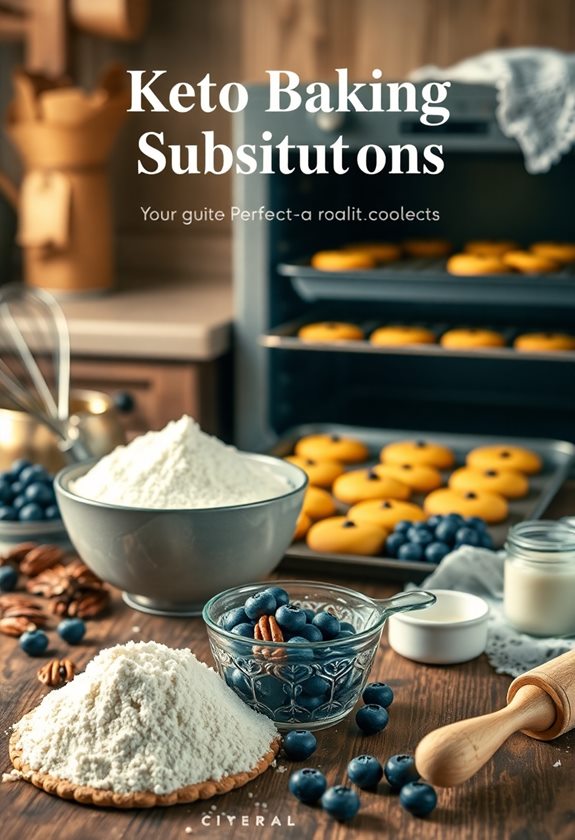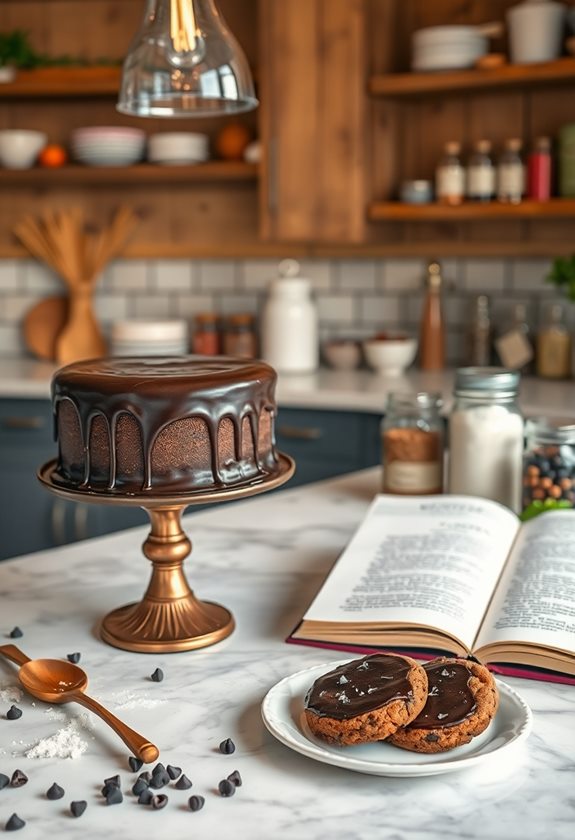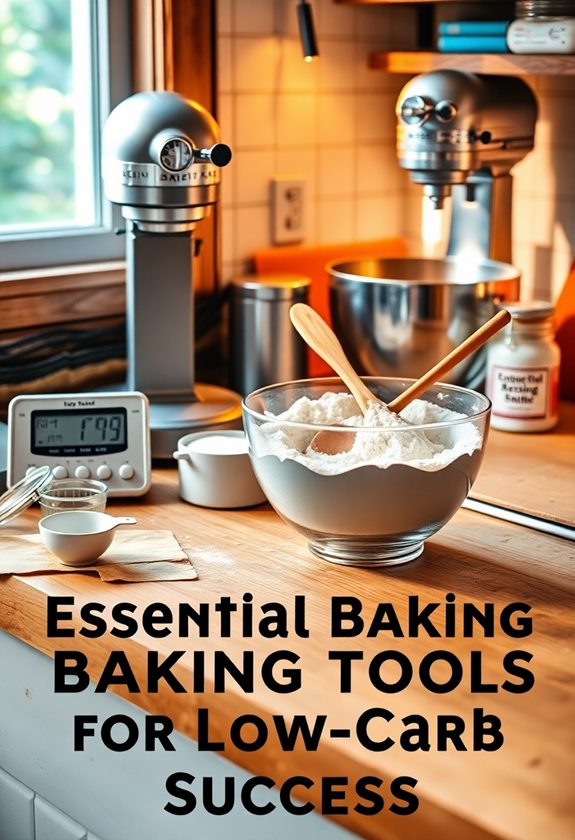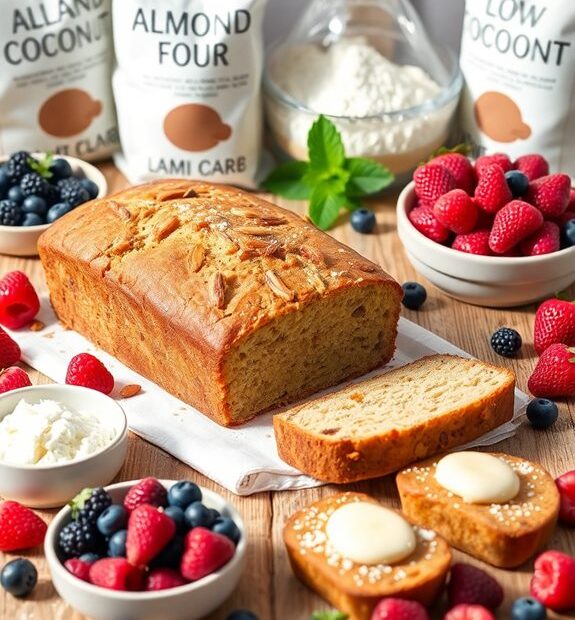Low-carb baking can be fun and rewarding! Start by using almond flour or coconut flour for your base. Have you tried adding pumpkin puree or nut butters for moisture and flavor? Don't forget sugar substitutes like erythritol to keep it sweet without the carbs. For texture, add crunchy nuts or seeds. Make chocolate chip cookies or a rich chocolate cake using these tips! Always check ingredient labels for hidden sugars and carbs. Using the right tools, like a kitchen scale, can also help. Curious about more ways to make your low-carb treats even better? There's so much more to explore!
Key Takeaways
- Use low-carb flours like almond and coconut flour, adjusting liquid amounts for coconut flour's high absorbency.
- Choose sugar substitutes like erythritol, stevia, or monk fruit for a low-carb sweetening option.
- Incorporate moist ingredients like pumpkin puree or nut butters to enhance texture and flavor in baked goods.
- Keep an eye on ingredient labels to avoid hidden sugars and ensure low-carb integrity.
- Utilize essential baking tools such as a kitchen scale and silicone mats for precise measurements and easy cleanup.
Keto Baking Substitutions

When you immerse yourself in keto baking, swapping out traditional ingredients is essential for keeping your carb count low. Using low-carb flours like *almond flour* and *coconut flour* is a game changer. These flour alternatives help you create *keto-friendly baked goods* without the guilt. Have you tried almond flour? It's versatile and has a mild flavor, making it ideal for delicate baked goods like macarons and cookies, as highlighted in the best almond flour options. Coconut flour, on the other hand, has high absorbency, so you'll need to adjust your liquid amounts.
Don't forget about sugar substitutes! Erythritol, stevia, and monk fruit are great options that won't mess with your blood sugar. If you want a one-to-one measure, try *Swerve Sweetener*. It's heat stable and perfect for baking. Just imagine biting into a delicious muffin that's low in net carbs!
Always check ingredient labels for hidden sugars and carbs. Not all sugar substitutes work the same way, and some might affect your baked goods' texture. By using these simple substitutions, you can enjoy *traditional recipes* in a healthier way without sacrificing flavor. Happy baking!
Flavor and Texture Tips
How can you elevate the flavor and texture of your low-carb baked goods? Start by incorporating moist ingredients like pumpkin puree or mashed banana. They not only add sweetness but also help prevent dryness in your keto recipes. You can also experiment with nut butters, seeds, and spices like cinnamon or cardamom to create exciting flavor profiles.
To add texture, consider introducing crunchy elements like nuts, seeds, or coconut flakes. This contrast makes your baked goods even more enjoyable. Here's a simple guide to help you:
| Ingredient Type | Examples |
|---|---|
| Moist Ingredients | Pumpkin puree, mashed banana |
| Flavor Boosters | Nut butters, spices |
| Crunchy Elements | Nuts, seeds, coconut flakes |
| Unique Combos | Cacao powder, avocado |
Don't forget to keep an open mind! Seasonal flavors can inspire you. So, why not try a new combination? This way, you'll discover delicious ways to enjoy low-carb baking while keeping things interesting.
Creative Keto Recipes

Creative keto recipes open up a world of delicious possibilities for your low-carb baking adventures. Have you ever tried making low-carb chocolate chip cookies using nut butters and almond flour? They're chewy, tasty, and guilt-free! You can also whip up a rich chocolate cake with cacao powder, almond butter, and avocado. It's a delightful way to enjoy dessert without the carbs. For an extra boost of flavor and nutrition, consider adding Kiss My Keto bars to your baking for a delicious chocolatey touch.
Don't forget to play with seasonal flavors! Adding pumpkin puree or spices like cinnamon and nutmeg can give your treats a festive twist that everyone will love. For an invigorating dessert, try a keto-friendly chia pudding made with chia seeds and unsweetened coconut milk. Just sweeten it with your favorite sugar alternatives.
Want to explore unique flavors? Adding extracts like vanilla or almond can elevate your baked goods without adding carbs. And if you're looking for a tasty snack, combine flax meal with your favorite nut butter to create a variety of delicious, low-carb treats. With these creative keto recipes, you'll enjoy baking with keto ingredients while satisfying your sweet tooth!
Ingredient Label Insights
Maneuvering ingredient labels can feel overwhelming, especially when you're committed to low-carb baking. But don't worry! Understanding these labels is key to making delicious treats without the carbs.
Start by checking out sugar substitutes. Look for those marked "net zero blood glucose impact," like Swerve Sweetener and monk fruit extract. Did you know erythritol has a glycemic index of zero? It's perfect for keto baking! Remember, it's about 70% as sweet as sugar, so you can swap it cup-for-cup.
Next up, low-carb flours like almond flour and coconut flour are staples. Familiarizing yourself with their properties can help you adjust your recipes. And don't forget to check baking powders for hidden carbs! They can contain starch, which adds extra carbs you might not expect.
Here's a quick reference table for you:
| Ingredient | Net Carbs per Serving |
|---|---|
| Almond Flour | 2g |
| Coconut Flour | 6g |
| Erythritol | 0g |
With these tips, you'll feel more confident as you bake. What will you create next? 🍰
Essential Baking Tools

In the world of low-carb baking, having the right tools at your fingertips can make all the difference. Are you ready to elevate your baking game? Start with a kitchen scale. It's essential for precise measurements, especially with low-carb flours like almond meal and coconut flour, which can differ in density. Consider incorporating essential meal prep equipment to streamline your baking process further.
Don't forget your measuring spoons and cups! Accurate portioning of ingredients is vital for successful baking outcomes. Stock up on key baking staples, including xanthan gum, to help achieve the right texture in your treats.
When it comes to baking surfaces, silicone baking mats and parchment paper are lifesavers. They prevent sticking, which is super helpful since low-carb batters can be a bit more adhesive.
Lastly, invest in a good-quality handheld mixer. This tool will make blending your ingredients a breeze, ensuring a smooth batter. With these essential tools in your kitchen, you're well on your way to mastering low-carb baking. So, what are you waiting for? Get inspired and start creating delicious, low-carb treats today!
Frequently Asked Questions
How Do You Reduce Carbs in Baked Goods?
You can reduce carbs in baked goods by substituting traditional flours with low-carb alternatives, using sugar substitutes, adding binding agents, adjusting liquid ratios, and experimenting with spices or nut butters for extra flavor.
Does Baking Powder Add Carbs?
Think of baking powder as a tiny sprinkle of magic. Yes, it does add carbs—about 1 carb per 1/4 teaspoon. So, if you're counting carbs, always check labels and measure carefully!
What Is a Keto Bakery?
A keto bakery specializes in low-carb baked goods, using alternative flours and sugar substitutes. You'll find delicious treats that fit your ketogenic diet, offering guilt-free options for health-conscious consumers seeking unique flavors and textures.
Is Keto Baking Healthy?
Studies show that keto baking can lead to reduced blood sugar levels by up to 30%. It's healthier than traditional methods when you choose quality ingredients and monitor your portion sizes. Enjoy the benefits mindfully!

